Abstract
Recently, technologies such as big data, artificial intelligence, and machine learning have been applied to intelligently and effectively operate fourth-generation (4G) and fifth-generation (5G) network systems. In particular, we are interested in using them in 4G mobility management entities and 5G access and mobility management functions (AMFs), where functional enhancement or performance improvement is required. This paper presents an enhanced paging approach based on supervised machine learning and a Markov process for the performance improvement of paging in 5G AMFs. User equipment (UE) profile information in 5G AMFs classifies subscribers into two types using a UE classifier model with k-nearest neighbors (KNN)-supervised learning. In this paper, UE movement data between next-generation NodeBs (gNodeBs) are analyzed, and the Markov process is applied to construct a transition probabilistic model. When a UE moves to an adjacent gNodeB in the 5G connection management-idle state, a method for predicting the gNodeB movement is required to perform paging effectively on the predicted gNodeBs. In the proposed paging method, the AMF applies the UE profile information to the KNN-supervised learning model and classifies the subscriber UE type. In addition, on the UE movement between gNodeBs statistics, it generates state-transition probabilities and then performs paging on the gNodeB list. Experimentally, the paging responses and signals of the proposed method are compared with the existing paging methods and presented with the result that the UE location is identified using the recently visited gNodeB list in the tracking area of the AMF.
1. Introduction
Technologies leading the recent fourth industrial revolution, such as big data, artificial intelligence, and the Internet of Things (IoT), are expected to play an important role in fifth-generation (5G) networks. By 2025, the number of 5G subscribers is expected to reach 26 billion people [1]. In particular, 5G requires ultra-high speed, hyper-connectivity, and ultra-low latency to provide various services through the network [2]. Therefore, in 5G mobile communication, providing ultra-low latency connections to user equipment (UE) and supporting numerous IoT devices are critical in both the core networks and radio access networks. When an access and mobility management function (AMF) is required for communication with the UE and IoT devices, the AMF performs a paging process to notify its transmission to the UE through the gNodeB [3]. When the UE moves to an adjacent gNodeB, it is registered with the corresponding gNodeB. However, when assuming that the UE moves frequently between gNodeBs, the mobility registration procedure of the AMF between the gNodeB and UE consumes a significant amount of unnecessary radio resources. Because not all mobility registration procedures of UE are reported to the AMF, the latter is expected to page multiple gNodeBs for the actual connection with its managed UE, which degrades the performance of the entire mobile network, e.g., increased signal processing load and increased latency.
In studies pertaining to the paging procedure in the 4G network, various methods afford improvements that reduce the performance degradation of the mobility management entity (MME) owing to the paging process. The results of improvements such as load reduction and delay reduction, which were predicted in a related study, have not been proven through application to actual commercial 5G systems [4]. Hence, the improvement in 5G networks was not confirmed.
Herein, the effect of applying machine learning to the AMF paging process in a 5G core network is discussed. Paging is the process of determining the location of the UE and is used to inform the UE of subscribers regarding the arrival of the voice or data to be delivered to the UE in the connection management (CM)-idle state. In the 5G AMF-initiated paging procedure, when the AMF receives the N1N2 message transfer signal from the session management function (SMF), it transmits the next-generation application protocol (NGAP) paging signal to the gNodeB in the tracking area (TA). Subsequently, when the AMF does not receive a response from the gNodeB to the completion of the connection of the radio resource with the UE within a certain duration, the AMF retransmits the NGAP paging signal to the gNodeBs in all the TAs. The maximum number of paging attempts was set in the paging profile configuration of the AMF, and the proportion of these paging signals constituted approximately 30% of the total signals processed in the AMF, which was an important target of performance improvement for the AMF and imposed a significant burden on the load as well as the linked gNodeB simultaneously. These were applied to the AMF based on the results of analyzing the signal statistics of the MME collected from several LTE commercial systems; the paging signal portion was in the range of 20% to 40%. In more detail, averages of other signals consisted of paging, 25%, UE-triggered service, 38%, MME-triggered service, 25%, and attach or tracking area update, 28%, respectively. Therefore, in a 5G wireless communication environment that requires hyper-connectivity with the UE, the paging process must be improved by reducing the paging signal load of the AMF and gNodeB. We believe that the proposed method should provide the enhanced paging performance and lead to successful 5G system commercialization and establishment.
A probabilistic paging method using supervised machine learning and a Markov process instead of the typical paging method is proposed and introduced herein. Section 2 describes the existing paging procedure. Section 3 presents the proposed paging method and procedure using supervised machine learning and the Markov process. Section 4 describes the experimental environment and provides an evaluation of the proposed method based on experimental results. Finally, Section 5 presents the conclusions of the proposed method.
2. Background
5G Paging
In 5G systems, the number of gNodeBs is greater than that in 4G long-term evolution owing to 5G service characteristics such as hyper-connectivity and 5G new radio frequency band features. As shown in Figure 1, the AMF manages these gNodeBs, the TA, and the TA list including multiple TAs, which comprise several adjacent gNodeBs. The UE initially sends a registration request to the AMF and then receives a registration accept message and the TA list managed by the AMF. When the UE moves to a new TA that is not in the TA list, it performs registration with its AMF and receives a new TA list [5].
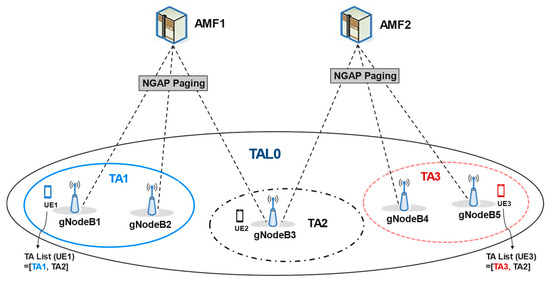
Figure 1.
Next generation application protocol (NGAP) paging of 5G system.
In general, when the UE is in the CM-connected state, the AMF knows the location information such as the gNodeB and cell information of the UE. If traffic data are transmitted to the UE, they may be directly transmitted to the UE via the connected channel of the radio resource. However, when the UE is in the CM-idle state, the AMF contains only the UE’s last visited gNodeB, latest visited gNodeBs, and TA [6]. When the UE moves outside the current TA, the UE reports its TA change to the AMF via the mobility registration update procedure, which is periodically operated based on the periodic registration update timer received from the AMF in the registration procedure. Subsequently, the AMF stores a new TA in the latest visited TAs of the UE and updates the TA list [7]. Next, the AMF can notify the data transmission or initiate a voice call to the UE when it is ready for transmission to the UE in the CM-idle state.
As shown in Figure 2, the AMF can initiate paging when it receives an N1N2 message transfer message from the SMF. The AMF verifies the connection status of the corresponding UE [8]. At this time, if the UE is in the CM-idle state, the AMF selects gNodeBs in which the UE is likely to exist and transmits paging signals to the gNodeBs based on the NGAP. Subsequently, these gNodeBs broadcast paging signals to all cells via a paging channel. Meanwhile, the UE monitors the wireless paging channel connected to the gNodeB. If the paging signal is identified, then the state is changed to the CM-connected state with the gNodeB; subsequently, the traffic data are transmitted from the user plane function to the UE [9].
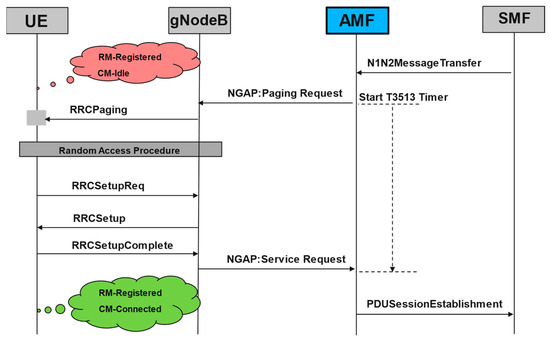
Figure 2.
Flow of 5G network-initiated paging.
However, before performing paging to the UE, the AMF should decide the range of paging on the registered gNodeB, TA, and TA list. The paging profile configuration in Table 1 shows that it has various paging conditions to be assigned for the different UE service types. The configuration includes the paging range, number of paging attempts, and paging profile created by the UE service type.

Table 1.
Example of AMF paging profile configuration showing the number of paging attempts in each case.
Figure 3 shows an example of the paging range profile. When No. 20 of the paging profile configuration in Table 1 is selected, the first paging message, based on the configuration, is sent up to three times to the last visited gNodeB. If no response is received from the gNodeB within a certain duration, then the same paging message is sent up to two times to the gNodeBs in the latest visited gNodeB list as the second attempt. Subsequently, the third paging attempt can be sent up to two times to all gNodeBs in the last visited TA when no response is obtained from the gNodeBs. As the last paging attempt, a paging message is sent up to two times to the gNodeBs of all TA lists. In other words, the number of paging attempts and the range of gNodeBs for paging are set in the AMF paging profile configuration [10].
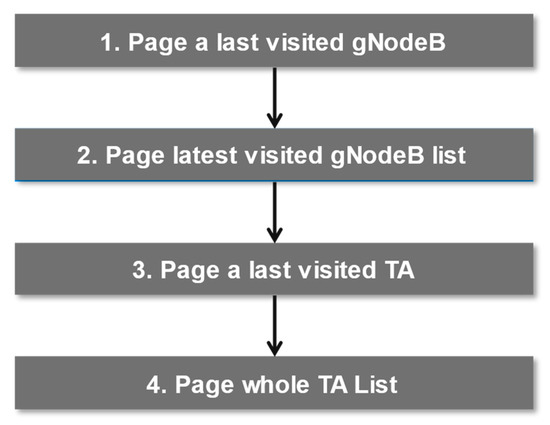
Figure 3.
Typical AMF paging range profile.
Figure 4 shows an example of UE movement between gNodeBs and the typical paging range in an AMF. Based on the paging range order in Figure 3 and paging profile configuration No. 20 in Table 1, the first paging message is sent to gNodeB0, the second to gNodeB0, gNodeB3, gNodeB4, and gNodeB5, and the third to all gNodeBs from gNodeB0 to gNodeB5 in the TA.
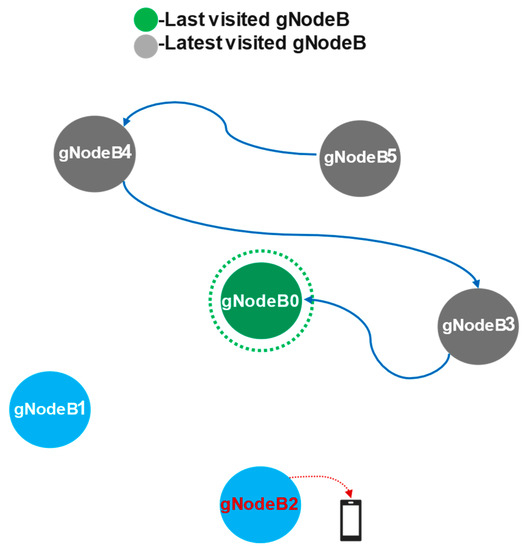
Figure 4.
Example of paging on latest gNodeB list.
3. Proposed Machine Learning-Based Paging
3.1. K-Nearest Neighbor (KNN)
KNN is a method that determines the category of a new data point by selecting the K closest points from the training data and classifying the new data into one of the categories [11,12,13]. The KNN uses the Euclidean distance to measure the distance to the target point [14].
If the value of K is small, then the classification becomes sensitive to noise and overfitting occurs. Conversely, if the value of K is large, then underfitting occurs and computation becomes expensive. Therefore, the K value should be selected appropriately based on the amount of data and the number of classes to be classified.
3.2. Markov Process
The Markov process uses probability to model the manner in which a certain state changes over time. When the past states and present state are specified, it is assumed that the future state is determined only by the present state; hence, the past state does not directly affect it [15,16]. Therefore, this can be expressed as follows:
When a change occurs from state at time to the next state at time the state-transition probability is expressed as follows:
The Markov process with the state-transition probability matrix converges to a stable probability distribution at a certain point in time through several transition processes [17].
3.3. Proposed Paging
3.3.1. Proposed Algorithm
In this paper, a paging method using supervised machine learning and the Markov process was proposed for the 5G AMF. Firstly, a UE classifier was implemented using KNN-supervised machine learning to classify subscribers based on the characteristics of UE movement patterns. Meanwhile, UE movement was monitored at the AMF when the UE moved to adjacent gNodeB. Secondly, statistics were used to predict the current gNodeB of the moving UE and the recent gNodeB transition probabilities obtained from the UE movement.
The dataset of the UE profile information used for supervised learning was as follows:
- First registration time: The time at which the first registration in the AMF was completed
- Last registration time: The time at which the last registration/service was performed in the AMF
- Last update type: The last UE registration type
- Last service type: The last UE service type
- gNodeB/TAC: The UE’s latest gNodeB/TAC information
- Latest TA list: The UE’s latest TA list information
For UE classification, we considered various classifiers such as the KNN, random forest, decision tree, and SVM, applied with the UE profile information, shown in Table 2, registered to the AMF. However, UE profile information for the 5G AMF was hardly obtained because 5G services were not fully commercialized. Therefore, the UE profile information obtained in the 4G MME was converted to satisfy the 5G technical specifications and used in our experiment.

Table 2.
UE profiled dataset.
Subscribers were classified into two UE groups, as shown in Table 3. One UE group included local residents and office workers who did not move significantly daily, and the other UE group included travelers, non-office workers, etc. We expected the overall paging performance to have improved by classifying the UE with the supervised learning and applying the weight to the confidence level used for probabilistic gNodeB selection during the paging process. The grouping of UE was to reduce paging signals with a smaller gNodeB list per group classified according to the number of UE movements.

Table 3.
UE group category.
For the experiment involving four classification models, i.e., KNN, random forest, decision tree, and SVM, 1000 UE profile data of every 20 min cycle were observed for five days, and four days data were applied to supervised learning. Then, 1000 UE profile data for the last one day were used for the performance evaluation of the four models [18].
Performance evaluation of the classification models was conducted using scikit-learn, a machine learning library of the Python programming language [19].
Figure 5 shows the test results for the classification accuracy. In this classification evaluation, we set a K of 20 in the KNN model, and entropy gain and estimators of 100 in the random forest model. In addition, we used the entropy criterion in the decision tree model and the linear kernel model with regularization of 10, and gamma of 0.1 in the SVM model. We observed that both the KNN and SVM models, which were candidates for our UE classification model, provided satisfactory classification accuracy. In addition, the simplicity and convenience of implementing the supervised learning classifier model in the AMF were considered for the classification model selection. In our work, the KNN model for classification was selected in the AMF of this paper owing to its high accuracy, simple code implementation, and low computation complexity compared to other models. The KNN model did not need any additional processing of the data, but the simple comparison with the reference provided a low-cost, simple but effective method.

Figure 5.
Classification accuracy for UE grouping.
As shown in Figure 6, the proposed probabilistic paging algorithm applied with machine learning in the AMF was categorized into two functions, as follows: The first function obtained the UE profile information in the AMF and conducted a UE classifier model applied using machine learning. In the paging experiment, when paging was attempted toward the target UE, the weight ratio of the UE group, which was obtained by performing the UE classifier model, was used to select the appropriate gNodeB.
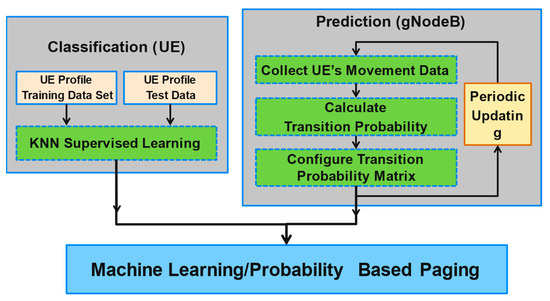
Figure 6.
Algorithm of proposed machine learning-based paging.
The second function obtained the UE movement around the gNodeBs and then classified the UE movement acquired by the gNodeB. The transition probability for each gNodeB was sorted in descending order to perform the probabilistic paging method.
By periodically performing these processes at the AMF, each gNodeB updated the transition probability using the latest UE movement data that was changed most recently. The paging method with KNN-based UE classification and UE movement prediction for gNodeBs was performed by substituting the second step of the typical paging range profile shown in Figure 7.
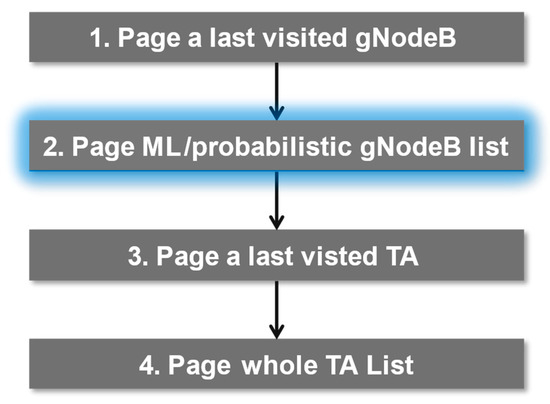
Figure 7.
Proposed AMF paging range profile.
Therefore, when the AMF used the gNodeB list for the second step of paging, the paging range was selected by the UE classifier applied with the KNN model and the probabilistic gNodeB list proposed herein.
When the proposed paging was not activated, as shown in Figure 7, the AMF attempted paging based on the latest visited gNodeB list in terms of the second paging range.
3.3.2. Proposed Process
The AMF selected the final gNodeBs from the probabilistic gNodeB list for paging based on a combination of three variables: the weight ratio of the UE group in the UE classifier model result, the transition probability of the gNodeB, and the confidence level in the paging profile configuration. During paging, the weight assigned to each UE group was applied to the UE when probabilistic gNodeBs were selected. In this paper, the AMF classified the UE into two UE groups, as shown in Table 3, and acquired the UE profile information of these UE groups.
To predict the UE movement to the gNodeBs, the AMF periodically acquired a significant amount of UE movement data between gNodeBs and the UE profile information from the registration step processed by UE mobility events. For example, the periodic or mobility registration update, service request, and handover procedures in 5G contained the latest UE movement data. After obtaining the UE movement data between the gNodeBs, the AMF periodically combined with the newly acquired UE movement data. The training data were obtained by multiplying the decay factor for past UE movement data at the current point and calculating the transition probability of moving from one gNodeB to all of its adjacent gNodeBs.
The confidence level of the paging profile configuration, a set of configurable probability values, was a threshold terminating the process of selecting gNodeBs for the paging process. The confidence level included one or more probability values that provided backup confidence level values for retries, even if the first paging attempt failed. Therefore, the number of probability values of the confidence level was equal to the number of paging attempts configured for each paging step in the AMF paging profile configuration. The confidence level could be set in units of the entire AMF or the paging profile configuration. When both were set, the confidence level of the paging profile configuration was prioritized.
The number of gNodeBs used in this paper was 1300; the number of possible states in the transition matrix. The transition matrix of all gNodeBs was as follows:
where was the transition probability from state i to state j.
At the evaluation of the proposed AMF paging experiment, the transition probabilities of all gNodeBs were recalculated every 20 min, and its result was used in the Markov process. Figure 8 shows five gNodeBs, and UE movement data of them are given to easily explain the proposed process without the collected UE movement data of 1300 gNodeBs used in this paper.
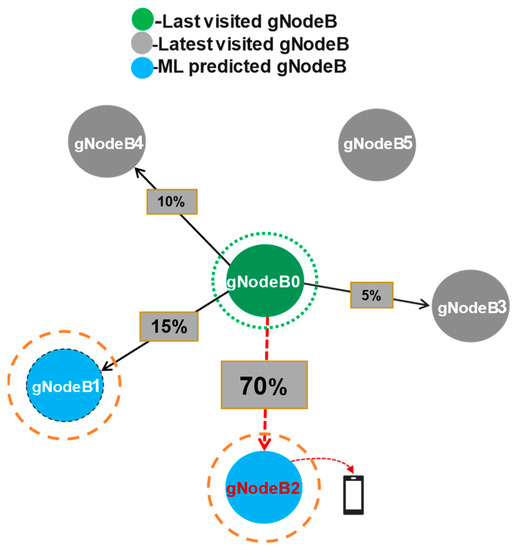
Figure 8.
Example of proposed machine learning-based paging.
Figure 8 shows an example of probabilistic gNodeB paging applied with machine learning, where the AMF selects gNodeB2 with the highest transition probability based on the last visited gNodeB0, then gNodeB1 with the second highest, followed by gNodeB4 with the next highest. When the sum of the accumulated transition probabilities of the selected gNodeBs satisfied or exceeded the probability value of the specified confidence level, no further gNodeBs were selected for the paging attempts. The paging range profile showed that the AMF always paged to the last visited gNodeB0, along with the selected gNodeBs, in every paging attempt.
The example shown in Figure 8 illustrates the manner by which the AMF performs paging based on the probabilistic gNodeB list applied using machine learning.
The AMF analyzed the movement data of UE in the last visited gNodeB0 and measured the transition probabilities of four adjacent gNodeBs (gNodeB1, gNodeB2, gNodeB3, and gNodeB4) from gNodeB0, as shown in Figure 8, and the transition probabilities were sorted in the descending order [20]. We defined there were five states of gNodeB0, gNodeB1, gNodeB2, gNodeB3, and gNodeB4.
The AMF selected the gNodeB to perform paging in the order from the gNodeB with the highest to lowest transition probability. The Markov process was implemented as follows: The state transition probabilities for each gNodeB were based on the UE movement from gNodeB0. In this example, the total number of UE that moved from gNodeB0 to the neighboring gNodeB is 2000. If the number of UE that moved to gNodeB2 was 1400 with 70% transition probability, gNodeB1 was 300 with 15% transition probability, NodeB4 was 200 with 10% transition probability, and gNodeB3 was 100 with 5% transition probability [21,22]. Therefore, we set the transition probability as p00 = 0, p01 = 0.15, p02 = 0.7, p03 = 0.05, and p04 = 0.1.
If No. 4 of the paging profile configuration in Table 4 was selected, the number of paging attempts was set to three, and the confidence level for the node criterion was set to three probability values: 0.7, 0.8, and 0.9. Subsequently, the AMF performed three paging attempts in the following second machine learning-based probabilistic paging.

Table 4.
Example of the proposed AMF paging profile configuration.
In step one of paging, the AMF first selected gNodeB2. In this regard, the transition probability of gNodeB2 was 0.7, which was equal to or greater than the first probability value (0.7) at the confidence level. Next, when the target UE was classified into UE group 2 by the UE classifier model, gNodeB was assigned the corresponding weight ratio (100%), as shown in Table 5. Therefore, the AMF attempted to page gNodeB2 and gNodeB0.

Table 5.
Example of weight table of UE group.
In step two of paging, if step one of paging failed, the AMF selected gNodeB2 and gNodeB1, where the transition probabilities of the two gNodeBs were 0.85, which was equal to or greater than the second probability value (0.8) in the confidence level. Next, if the target UE was classified into UE group 1 by the UE classifier model, the gNodeB was assigned a corresponding weight ratio (50%). Therefore, the AMF finally paged gNodeB0 along with gNodeB2; however, by applying a weight ratio of 50% to the gNodeBs, gNodeB1 was excluded from the paging attempts.
In step three of paging, if step two of paging failed, then the AMF selected gNodeB2, gNodeB1, and gNodeB4, where the sum of the transition probabilities of the four gNodeBs was 0.95, which was equal to or greater than the third probability value (0.9) at the confidence level. Next, if the target UE was classified as UE group 1 by the UE classifier model, the AMF selected gNodeBs with a weight ratio of 50%. However, the AMF attempted to page gNodeB2, gNodeB1, and gNodeB4 together with gNodeB0. Because the AMF had a history of paging failure to which a weight ratio was previously applied, the weight ratio (100%) was applied instead of the weight ratio (50%) of UE group 1 in the UE classifier model.
The proposed paging system excluded the gNodeB with the lowest transition probability among the candidates selected from the gNodeB list based on the transition probability and confidence level of the gNodeB. After machine learning-based probabilistic paging was activated, the number of paging attempts, confidence level of the paging profile configuration, weight assignment of the UE classifier model, and period of updating and measuring the probabilistic value based on the acquired UE movement data was optimized repeatedly to obtain the best gNodeB paging performance results.
4. Experiment and Results
4.1. Experiment Environment and Scenario
For the performance evaluation of the probabilistic paging method applied with machine learning, the AMF system consisting of the UE classifier, probabilistic paging, and the 5G system implemented is shown in Figure 9.

Figure 9.
Experiment environment for proposed paging.
The experimental environment was developed by constructing a VM-based 5G simulator using scripts such as periodic or mobility registration update procedures, service request procedures, and paging processes.
In addition, as shown in Table 6 and Figure 10, UE movement data of approximately 200,000 UE and approximately 1300 gNodeBs were obtained from a commercial MME system for one week. Subsequently, they were fit and adjusted for the experimental environment of the standard 5G specification. In addition, the KNN-supervised learning-based UE classifier model was conducted using the UE profile information of the 1000 subscribers. The UE group of subscribers were classified into UE group 1, which included local residents and office workers who moved less between gNodeBs, and the remaining were classified as UE group 2. The settings for all the gNodeBs and UE were organized in the order of time in the 5G simulator, whereas the gNodeB list and transition probability based on the proposed method were updated every 20 min.

Table 6.
Example of UE movement data. Mo-data: mobile originating-data, mt-access: mobile terminating-access, and mo-signaling: mobile originating-signaling.
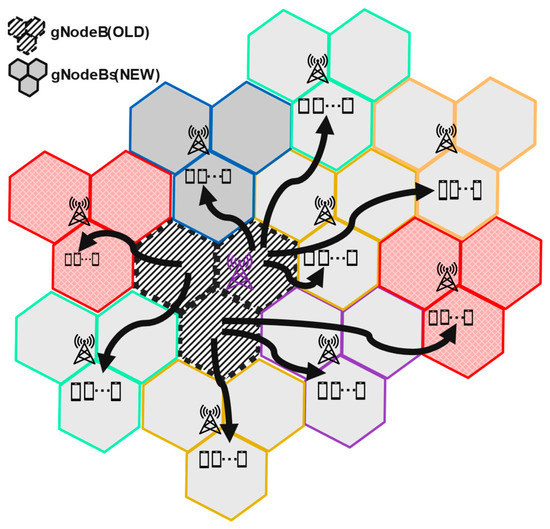
Figure 10.
Example of UE movement path from gNodeB (OLD).
Figure 11 shows the experimental scenario. When the UE sent a periodic or mobility registration and service request message to the AMF, the AMF stored the UE movement data in the gNodeB DB, generated the UE classifier model, and updated the machine learning paging table. When the SMF sent a service request message to the AMF, the AMF verified the UE state and performed probabilistic paging with machine learning.
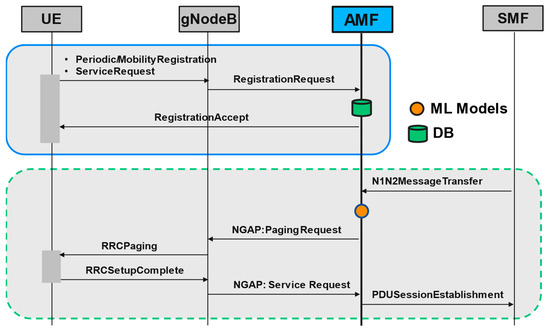
Figure 11.
Experiment scenario for proposed paging system.
4.2. Experiment Results and Evaluation
The paging profile configuration of the AMF used in the experimental environment was as follows: The typical paging approach was implemented via only one attempt from the first paging range with the last visited gNodeB to the fourth paging range with TA list paging. Meanwhile, the proposed machine learning-based probabilistic paging did not attempt the first paging with the last visited gNodeB, and the second paging based on the probabilistic paging method applied with machine learning was attempted three times. The confidence level of the paging profile configuration was set to 0.7, 0.8, and 0.9, and the weight ratio of UE groups 1 and 2 of the KNN-supervised learning-based UE classifier model was set to 50% and 100%, respectively, after which the statistics regarding the paging signals were obtained from the AMF. Subsequently, the experimental results were compared with each other. For the performance evaluation, three cases were performed: typical paging, probabilistic paging applied with the Markov process, and probabilistic paging with the KNN-supervised learning-based UE classifier model and Markov process.
Figure 12 shows the change in the overall paging signal. As shown in Figure 12, when probabilistic paging was conducted, the total number of paging signals in the AMF decreased by 60% as compared with the typical paging shown in Figure 3, because the remaining paging steps of the paging profile configuration were not performed after the success of the paging. When the proposed probabilistic paging with machine learning was applied, the total number of AMF paging signals reduced by 70% compared with that of the typical paging.

Figure 12.
Total paging signals observed for different conditions of paging system.
In terms of the average number of signals per paging shown in Figure 13, the probabilistic paging method decreased it by 83%, whereas the probabilistic paging method with machine learning decreased it by 86%.
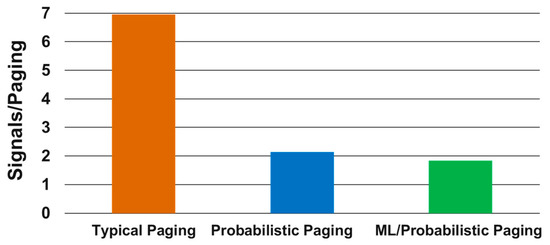
Figure 13.
Average paging signals observed for different conditions of paging system.
Based on the results of two previous experiments, we observed that the UE classifier model classified the UE into groups based on the subscriber type and assigned a weight ratio to select the best gNodeB. This reduced the overall paging signal and contributed positively to the AMF performance. In this experiment, all paging attempts were performed up to the entire TA list of the last step; therefore, the final paging success rate was the same for both the existing gNodeB list paging method and the proposed machine learning-based probabilistic paging method.
Figure 14 shows the number of paging signals per second over a week. As shown, the number of paging signals per second reduced by an average of 40–80% per day. In addition, the probabilistic paging method applied with machine learning showed that the number of paging signals per second reduced to 25% compared to the typical paging approach, owing to the probabilistic paging method involving a Markov process.
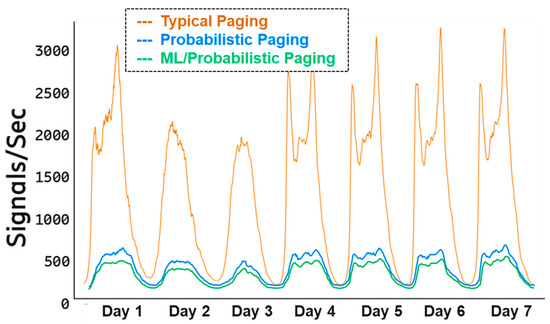
Figure 14.
Paging signals observed daily for different conditions of paging system.
5. Conclusions
In this paper, the structure and operation procedure of the probabilistic paging method applied with machine learning were proposed to reduce the number of paging signals in the 5G AMF system, and the performance was evaluated based on experiments on a 5G simulator and the AMF.
The proposed paging method reduced the average number of signals per paging and the total number of paging signals in the AMF compared with the typical paging method. The experimental results confirmed that it contributed to the improvement in the operational stability and performance of the AMF system.
Hence, the proposed probabilistic paging method applied with KNN machine learning is a supervised learning model with a relatively simple structure; furthermore, it is applicable to the commercial operating AMF system for predicting resource allocation and managing abnormal problems in 4G/5G core networks in advance.
Author Contributions
All authors contributed to the conceptualization and methodology of the manuscript, W.-K.C. contributed to writing, J.-Y.P. reviewed and edited the manuscript. All authors have read and agreed to the published version of the manuscript.
Funding
This study was supported by research fund from Chosun University, 2021.
Conflicts of Interest
The authors declare no conflict of interest.
References
- Ericsson. Ericsson Mobility Report. Available online: https://www.ericsson.com/49da93/assets/local/mobility-report/documents/2020/june2020-ericsson-mobility-report.pdf (accessed on 26 June 2020).
- Gupta, A.; Jha, R.K. A Survey of 5G Network: Architecture and Emerging Technologies. IEEE Access 2015, 3, 1206–1232. [Google Scholar] [CrossRef]
- 3GPP TS 38.413 V16.0.0, 3rd Generation Partnership Project; Technical Specification Group Radio Access Network; NG-RAN; NG Application Protocol (NGAP) (Release 16). 2020. Available online: https://www.3gpp.org/ftp/Specs/archive/38_series/38.413/38413-g00.zip (accessed on 2 June 2020).
- Jeong, J.-J.; Roeland, D.; Derehag, J. Mobility Prediction for 5G Core Networks. IEEE Commun. Stand. Mag. 2021, 5, 56–61. [Google Scholar] [CrossRef]
- 3GPP TS 24.501 V16.4.0, 3rd Generation Partnership Project; Technical Specification Group Core Network and Terminals; Non-Access-Stratum (NAS) Protocol for 5G System (5GS); Stage 3 (Release 16). 2020. Available online: https://www.3gpp.org/ftp/Specs/archive/23_series/24.501/24501-g40.zip (accessed on 29 July 2020).
- 3GPP TS 23.501 V16.5.0, 3rd Generation Partnership Project; Technical Specification Group Services and System Aspects; System architecture for the 5G System (5GS); Stage 2 (Release 16). 2020. Available online: https://www.3gpp.org/ftp/Specs/archive/23_series/23.501/23501-g50.zip (accessed on 29 July 2020).
- Liou, R.-H.; Lin, Y.-B.; Tsai, S.-C. An Investigation on LTE Mobility Management. IEEE Trans. Mob. Comput. 2013, 12, 166–176. [Google Scholar] [CrossRef]
- 3GPP TS 29.500 V16.4.0, 3rd Generation Partnership Project; Technical Specification Group Core Network and Terminals; 5G System; Technical Realization of Service Based Architecture; Stage 3 (Release 16). 2020. Available online: https://www.3gpp.org/ftp/Specs/archive/29_series/29.500/29500-g40.zip (accessed on 28 July 2020).
- 3GPP TS 38.331 V16.0.0, 3rd Generation Partnership Project; Technical Specification Group Radio Access Network; NR; Radio Resource Control (RRC) Protocol Specification(Release 16). 2020. Available online: https://www.3gpp.org/ftp/Specs/archive/38_series/38.331/38331-g00.zip (accessed on 18 July 2020).
- Xiao, Y.; Chen, H.; Du, X.; Guizani, M. Performance Analysis of Blanket Paging, Sequential Probability Paging, and Pipeline Probability Paging for Wireless Systems. IEEE Trans. Veh. Technol. 2007, 56, 2745–2755. [Google Scholar] [CrossRef]
- Cover, T.M.; Hart, P.E. Nearest neighbor pattern classification. IEEE Trans. Inf. Theory 1967, 13, 21–27. [Google Scholar] [CrossRef]
- Hart, P. The condensed nearest neighbor rule. IEEE Trans. Inf. Theory 1968, 14, 515–516. [Google Scholar] [CrossRef]
- Zhang, Z. Introduction to machine learning: K-nearest neighbors. Ann. Transl. Med. 2016, 4, 218. [Google Scholar] [CrossRef] [PubMed]
- Short, R.; Fukunaga, K. The optimal distance measure for nearest neighbor classification. IEEE Trans. Inf. Theory 1981, 27, 622–627. [Google Scholar] [CrossRef]
- Markov Chain. Available online: https://en.wikipedia.org/wiki/Markov_chain (accessed on 3 July 2020).
- Kim, E.-J. Introduction to Artificial Intelligence, Machine Learning, and Deep Learning through Algorithms; Wikibook.co.kr: Seoul, Korea, 2016; pp. 172–180. [Google Scholar]
- Trivedi, K.S. Probability and Statistics with Reliability, Queueing, and Computer Science Applications; John Wiley & Sons: Hoboken, NJ, USA, 2002; pp. 351–419. [Google Scholar]
- Supervised Learning. Available online: https://scikit-learn.org/stable/supervised_learning.html (accessed on 11 July 2020).
- Geron, A. Hands-On Machine Learning with Scikit-Learn and TensorFlow: Concepts, Tools, and Techniques to Build Intelligent Systems; O’Reilly Media: Sebastopol, CA, USA, 2017. [Google Scholar]
- Hashimoto, T.; Kubo, T.; Kitatsuji, Y. Lightweight paging based on location update intervals in LTE network. In Proceedings of the 2016 IEEE International Conference on Communications (ICC), Kuala Lumpur, Malaysia, 22–27 May 2016; pp. 1–6. [Google Scholar]
- Ariffin, S.; Abd, N.; Ghazali, N. Mobility prediction via Markov model in LTE femtocell. Int. J. Comput. Appl. 2013, 65, 40–44. [Google Scholar]
- Wang, X.; Jiang, X.; Chen, L.; Wu, Y. KVLMM: A Trajectory Prediction Method Based on a Variable-Order Markov Model with Kernel Smoothing. IEEE Access 2018, 6, 25200–25208. [Google Scholar] [CrossRef]
Publisher’s Note: MDPI stays neutral with regard to jurisdictional claims in published maps and institutional affiliations. |
© 2022 by the authors. Licensee MDPI, Basel, Switzerland. This article is an open access article distributed under the terms and conditions of the Creative Commons Attribution (CC BY) license (https://creativecommons.org/licenses/by/4.0/).